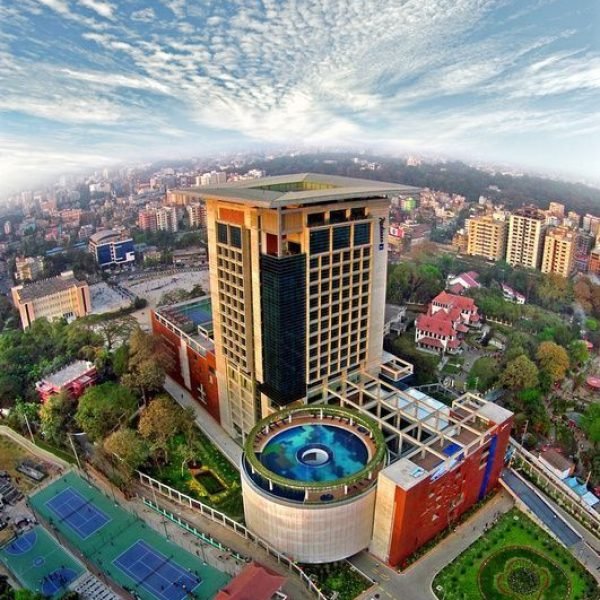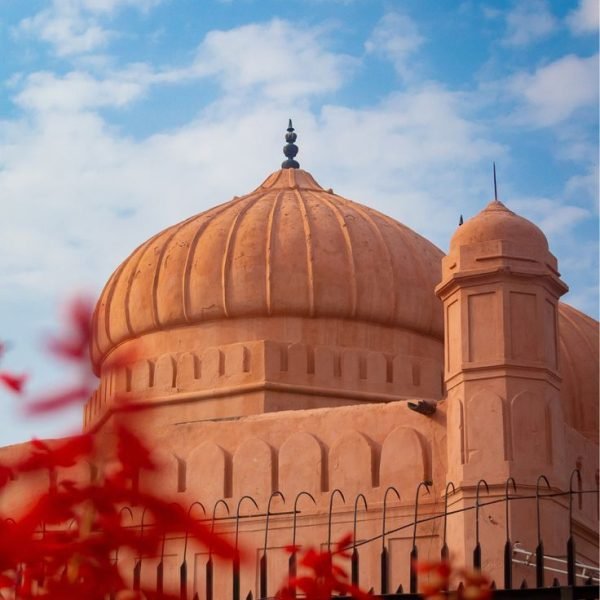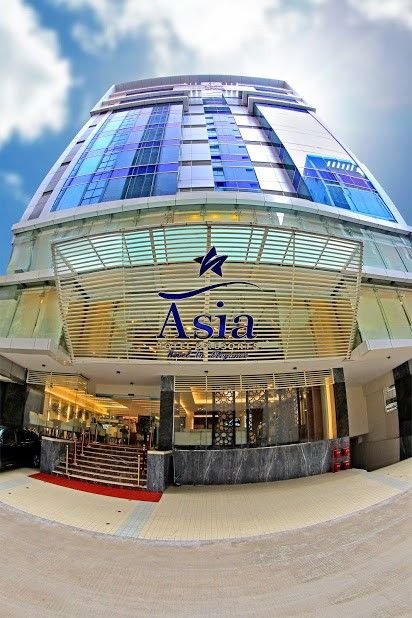Bangladesh
Welcome to Bangladesh
Bangladesh, a vibrant and culturally rich country in South Asia, lies on the eastern edge of the Indian subcontinent. Known for its lush green landscapes, sprawling river systems, and warm, hospitable people, Bangladesh offers travelers a unique blend of history, nature, and tradition. From bustling cities to tranquil beaches and dense mangrove forests, this diverse country invites visitors to explore its many facets, including ancient heritage sites, natural wonders, and lively urban life.
Bangladesh is a land of contrasts and surprises. Its capital, Dhaka, is a bustling megacity where modern skyscrapers stand alongside centuries-old architecture and vibrant street markets. The country is home to the world's longest natural sea beach at Cox’s Bazar, the vast Sundarbans mangrove forest—home to the elusive Bengal tiger—and the scenic Chittagong Hill Tracts with tribal cultures and rolling tea estates. Despite its rapid urbanization, much of Bangladesh remains deeply connected to its rural roots, with rice paddies, rivers, and traditional villages dotting the landscape. The people of Bangladesh are known for their kindness and hospitality. Travelers often find a warm welcome and a sense of belonging here, with locals eager to share their culture and help visitors navigate the country. Whether wandering through the chaotic yet charming streets of Old Dhaka or relaxing on the golden sands of Cox’s Bazar, visitors experience a genuine and friendly atmosphere.
1.
Rich Cultural Heritage and History: Bangladesh boasts numerous UNESCO World Heritage Sites, including historic mosques, forts, and archaeological ruins. The capital city Dhaka alone houses landmarks such as the Lalbagh Fort, Ahsan Manzil, and the National Museum, offering a deep dive into the country’s past and artistic traditions.

2.
Natural Beauty and Wildlife: From the Sundarbans, the largest mangrove forest in the world teeming with wildlife, to the serene beaches of Cox’s Bazar and the lush hills of the Chittagong region, Bangladesh is a paradise for nature lovers and eco-tourists. Adventure seekers can enjoy activities like river cruising, hiking, angling, and water sports.

Planning Your Trip
Visa Information
Most travelers to Bangladesh will require a visa, which can be obtained from Bangladeshi embassies or consulates abroad. Tourist visas are generally straightforward to apply for, with options for e-visas available to simplify the process. It is advisable to check the latest visa requirements and application procedures before planning your trip, as policies may evolve.
Best Time to Visit
The ideal time to visit Bangladesh is during the cooler, dry season from November to February. During these months, the weather is pleasant with mild temperatures and low humidity, perfect for sightseeing and outdoor activities. The monsoon season, from June to September, brings heavy rains and flooding, which can disrupt travel plans but also transforms the countryside into a lush green spectacle.
Getting To and Around
- Getting There: The main international gateway is Shahjalal International Airport in Dhaka, which connects Bangladesh to major cities worldwide. Other international airports include Shah Amanat International Airport in Chittagong and Osmani International Airport in Sylhet.
- Getting Around: Transportation within Bangladesh offers a variety of options. In cities like Dhaka, rickshaws, taxis, and ride-sharing services are common and convenient. For intercity travel, trains and buses connect major destinations, though journeys can be slow due to traffic and road conditions. Boats are also a popular mode of transport, especially in riverine areas and the Sundarbans. Tuk-tuks are widely used in coastal areas like Cox’s Bazar for short trips. While traveling independently can be challenging due to language barriers and infrastructure, the warmth of locals often helps visitors navigate smoothly.

Accommodation
Bangladesh offers a wide range of accommodation options catering to every type of traveler, from budget backpackers to luxury seekers. Whether you are visiting the bustling capital Dhaka, the serene beaches of Cox’s Bazar, the lush tea gardens of Sylhet, or the scenic hill tracts of Chittagong, you will find places to stay that suit your preferences and budget.
Accommodation Options
Types of Accommodation
- Luxury Hotels: For travelers seeking comfort and top-notch amenities, Bangladesh has several 5-star and 4-star hotels, especially in Dhaka and Chittagong. These hotels often feature modern facilities such as swimming pools, fitness centers, fine dining restaurants, and concierge services. Popular luxury options include Pan Pacific Sonargaon Dhaka and Radisson Blu Dhaka Water Garden, known for their excellent service and central locations.
- Mid-Range Hotels: There is a good selection of 3-star and 4-star hotels offering comfortable rooms with essential amenities at reasonable prices. Hotels like Hotel Noorjahan Grand in Sylhet and Jatra Flagship in Chittagong provide spacious rooms, friendly staff, and convenient access to city attractions. Many mid-range hotels include complimentary breakfast and Wi-Fi.
- Budget Hotels and Guesthouses: For travelers on a budget, Bangladesh has numerous guesthouses, hostels, and budget hotels. These accommodations provide basic facilities and clean rooms at affordable rates, often starting as low as $7 to $15 per night. Areas like Cox’s Bazar and Dhaka have many such options, ideal for backpackers and solo travelers.
- Unique Stays: Capsule hotels and boutique guesthouses are emerging in urban centers, offering a modern, compact, and affordable stay experience. Additionally, eco-lodges and homestays in rural and natural areas provide immersive cultural experiences and closer contact with local communities.
Popular Areas to Stay
- Dhaka: The capital city offers the broadest range of accommodations, from luxury hotels in Gulshan and Banani to budget options in Old Dhaka and Uttara. Dhaka’s hotels are well-connected to airports, business districts, and cultural sites.
- Cox’s Bazar: Famous for its long natural beach, Cox’s Bazar has many beachfront resorts, hotels, and guesthouses. Visitors can choose from luxurious seaside resorts to simple lodgings near the beach.
- Sylhet: Known for its tea gardens and natural beauty, Sylhet offers comfortable hotels and resorts that cater to tourists looking to explore the hills and waterfalls.
- Chittagong: As a commercial hub and gateway to hill tracts, Chittagong has a variety of hotels ranging from upscale to budget-friendly.
Booking Tips
- Booking in advance, especially during peak tourist seasons (November to February), can secure better rates and availability.
- Prices vary by location and season, with November being the most expensive month and July the cheapest.
- Many hotels offer free cancellation and breakfast included, so check policies carefully to get the best deal.

Food and Drink
Bangladesh’s cuisine is a vibrant reflection of its culture, geography, and history. Rich in spices, fresh ingredients, and traditional cooking methods, Bangladeshi food offers an exciting culinary journey for visitors.
Staple Foods and Popular Dishes
- Rice and Lentils: Rice is the staple food, usually served with lentils (dal), vegetables, and fish or meat curries. Meals are often hearty and flavorful, balancing spices with fresh herbs.
- Fish: Being a riverine country, fish is central to Bangladeshi cuisine. Hilsa (ilish) is the national fish and a delicacy, often cooked with mustard seeds or fried. Freshwater fish curries are common in daily meals.
- Curries and Meat Dishes: Chicken, beef, and mutton are popular, prepared in rich, aromatic curries with spices like turmeric, cumin, coriander, and chili. Beef kheema (minced meat) and chicken rezala are well-loved dishes.
- Street Food: Dhaka and other cities have vibrant street food scenes. Favorites include fuchka (crispy hollow puris filled with spicy tamarind water), chotpoti (spiced chickpeas and peas), and jhalmuri (spicy puffed rice snack).
- Sweets: Bangladesh is famous for its sweets, especially those made from milk. Rasgulla, sandesh, and mishti doi (sweetened yogurt) are popular desserts.
Drinks
- Tea: Tea is the most popular drink, often served strong and sweet with milk. Sylhet and the surrounding hill areas produce some of the best teas in the country.
- Fresh Juices and Lassi: Fresh fruit juices and lassi (a yogurt-based drink) are common, especially in warmer months.
- Local Beverages: Toddy (palm wine) is consumed in rural areas, though alcohol is generally limited due to cultural and religious reasons.
Dining Experiences
- Restaurants: Urban centers have a growing number of restaurants offering traditional Bangladeshi cuisine alongside Indian, Chinese, and international dishes. Many hotels have in-house restaurants serving authentic meals.
- Home-Cooked Meals and Homestays: Staying with local families or in homestays offers a chance to enjoy authentic home-cooked Bangladeshi food, often prepared with fresh, local ingredients.
- Food Safety: While street food is delicious and popular, travelers should ensure food is freshly prepared and drink bottled or purified water to avoid stomach issues.
Bangladesh’s accommodation and culinary offerings provide a rich and diverse experience for travelers. Whether you seek the comfort of a luxury hotel or the charm of a local guesthouse, and whether you want to savor traditional fish curries or sample vibrant street snacks, Bangladesh promises a memorable and authentic journey for every visitor.

Must-See Attractions
Bangladesh is a treasure trove of cultural heritage, natural beauty, and historical landmarks. Whether you are fascinated by ancient ruins, enchanted by pristine beaches, or eager to explore lush forests, Bangladesh offers a variety of must-see attractions that promise an unforgettable experience.
- Cox’s Bazar – The Longest Natural Sea Beach in the World
Cox’s Bazar is undoubtedly Bangladesh’s crown jewel for beach lovers. Stretching over 120 kilometers along the Bay of Bengal, it holds the title of the longest uninterrupted natural sea beach globally. The beach is famous for its golden sands, clean waters, and a relaxed atmosphere that attracts both local and international tourists. Visitors can enjoy sunrise and sunset walks, indulge in fresh seafood at beachfront eateries, or try water sports like surfing and jet skiing. Nearby attractions include Himchari National Park, known for its waterfalls and forest trails, and Inani Beach, famous for its coral stones and clear waters.
- The Sundarbans – UNESCO World Heritage Mangrove Forest
The Sundarbans is the world’s largest mangrove forest and a UNESCO World Heritage Site, shared between Bangladesh and India. This vast natural reserve is home to the iconic Royal Bengal Tiger, as well as diverse wildlife such as spotted deer, crocodiles, dolphins, and numerous bird species. Visitors can take guided boat tours through the winding waterways, explore dense mangrove forests, and experience the unique ecosystem. Recent improvements in eco-friendly tours and forest lodges have enhanced the visitor experience while preserving this fragile environment.
- Saint Martin’s Island – The Coral Island
Saint Martin’s Island is Bangladesh’s only coral island, located in the Bay of Bengal. It is a small, tranquil island known for its crystal-clear waters, coral reefs, and vibrant marine life. Popular activities here include snorkeling, scuba diving, and bioluminescent beach walks at night. The island’s laid-back vibe and natural beauty make it a perfect getaway for nature lovers and adventure seekers alike.
- Lalbagh Fort – Historical Mughal Fortress
Located in Dhaka, Lalbagh Fort is a 17th-century Mughal fort complex and one of Bangladesh’s most significant historical sites. Though incomplete, the fort houses beautiful gardens, a mosque, and the tomb of Pari Bibi. It was the site of early battles for independence and offers insight into Mughal architecture and history. The fort is a peaceful oasis in the bustling city and a must-visit for history enthusiasts.
- Ahsan Manzil – The Pink Palace of Dhaka
Situated on the banks of the Buriganga River, Ahsan Manzil is a stunning pink palace that once served as the residence of the Nawabs of Dhaka. Now a museum, it showcases the opulent lifestyle of the Nawabs with period furniture, paintings, and artifacts. Its distinctive architecture and riverside location make it one of Dhaka’s most photographed landmarks.
- Mahasthangarh – Ancient Archaeological Site
Mahasthangarh is Bangladesh’s oldest archaeological site, dating back to the 3rd century BC. Located near Bogra, it was the ancient capital of the Pundranagar kingdom. Visitors can explore ruins of city walls, temples, and ancient artifacts displayed in the site museum. This site offers a fascinating glimpse into Bangladesh’s ancient history and early urban civilization.
- Paharpur – Somapura Mahavihara
Paharpur houses the ruins of Somapura Mahavihara, one of South Asia’s largest Buddhist monasteries and a UNESCO World Heritage Site. The site dates back to the 8th century and is an architectural marvel with its symmetrical layout and intricate terracotta decorations. It is a pilgrimage site for Buddhists and a must-see for archaeology and history buffs.
- Sylhet and Srimangal – Tea Gardens and Spiritual Sites
Sylhet is famous for its rolling tea gardens, spiritual shrines, and natural beauty. Srimangal, known as the “Tea Capital of Bangladesh,” offers lush green landscapes, tea estate tours, and the serene Lawachara National Park. Sylhet is also home to the shrine of Hazrat Shah Jalal, a revered Sufi saint, attracting pilgrims and tourists alike.
- Bandarban and Rangamati – Hill Tracts and Tribal Culture
The hill districts of Bandarban and Rangamati offer breathtaking landscapes with hills, waterfalls, and lakes. Bandarban features attractions like Nilgiri Hills, Boga Lake, and Nafakhum Waterfall, while Rangamati is known for Kaptai Lake and indigenous tribal communities. These areas are perfect for trekking, cultural immersion, and eco-tourism.
- Jaflong – Scenic Hills and River Views
Located on the border with India, Jaflong is renowned for its picturesque hills, tea plantations, and the clear waters of the Dawki River. Visitors enjoy boat rides, glass-bottom boat tours, and local cultural festivals with the Khasi tribe. The area has seen improved eco-resorts and amenities, enhancing the visitor experience.

Must-Do Activities
Bangladesh offers a diverse range of activities that allow travelers to immerse themselves in its culture, nature, and history. Here are some top experiences to include in your itinerary.
- Beach Activities at Cox’s Bazar
Beyond relaxing on the golden sands, Cox’s Bazar offers numerous activities such as surfing lessons, beach volleyball, and boat rides. Early morning or evening beach walks are popular, as is sampling fresh seafood at local stalls and restaurants. Don’t miss visiting nearby Himchari Waterfall and Inani Beach for hiking and snorkeling.
- Wildlife Safari in the Sundarbans
A guided boat safari through the Sundarbans is a thrilling way to spot wildlife, including the elusive Bengal tiger, spotted deer, crocodiles, and various bird species. Eco-friendly tours often include visits to watchtowers, nature trails, and local villages, providing insight into the delicate balance of this unique ecosystem.
- Snorkeling and Diving at Saint Martin’s Island
Explore the underwater world around Saint Martin’s Island by snorkeling or diving to see vibrant coral reefs and marine life. Nighttime bioluminescent plankton displays create a magical experience on the beach. The island’s small size makes it ideal for cycling or walking tours to discover local fishing villages and beaches.
- Exploring Historic Dhaka
Take a walking tour of Dhaka’s Old City to visit landmarks like Lalbagh Fort, Ahsan Manzil, Star Mosque, and the Armenian Church. Explore bustling markets such as New Market and experience the vibrant street food culture. A boat ride on the Buriganga River offers a unique perspective of the city’s life and skyline.
- Tea Garden Tours in Sylhet and Srimangal
Visit tea estates in Srimangal to learn about tea cultivation and processing. Enjoy scenic walks through lush plantations and visit the Lawachara National Park to spot rare wildlife like the hoolock gibbon. Sampling locally grown tea and traditional sweets is a must.
- Trekking and Cultural Immersion in Bandarban
Embark on trekking expeditions to Nilgiri Hills, Nafakhum Waterfall, and Boga Lake. Engage with indigenous communities to learn about their customs, crafts, and lifestyles. Eco-friendly lodges and guided tours provide a sustainable way to explore this tranquil region.
- Archaeological Tours at Mahasthangarh and Paharpur
History enthusiasts can explore the ruins of ancient cities and monasteries. Guided tours at Mahasthangarh and Paharpur offer rich narratives about the region’s past civilizations, architecture, and religious heritage. Museums on-site display artifacts that bring history to life.
- River Cruises and Boat Rides
Bangladesh’s extensive river network makes boat rides a quintessential experience. From the busy Sadarghat river port in Dhaka to tranquil cruises in the Sundarbans or tea garden areas, river travel offers scenic views and a glimpse into local life. Traditional wooden boats and modern launches are widely available.
- Sampling Street Food and Local Cuisine
Indulge in Dhaka’s vibrant street food scene with treats like fuchka (puffed crispy shells filled with spicy water), chotpoti (spiced chickpeas), and jhalmuri (spicy puffed rice). Visit local markets and food stalls to taste authentic Bangladeshi flavors in an informal setting.
- Visiting Spiritual and Religious Sites
Bangladesh’s spiritual diversity is reflected in its mosques, temples, and shrines. Visit the Star Mosque with its beautiful star mosaics, the shrine of Hazrat Shah Jalal in Sylhet, and ancient Hindu temples like Kantajee’s Temple. These sites offer peaceful retreats and cultural insights.
Bangladesh in 2025 is a destination that blends natural wonders, rich history, and vibrant culture. From the serene beaches of Cox’s Bazar to the dense mangroves of the Sundarbans, from ancient archaeological sites to bustling urban markets, the country offers a wealth of attractions and activities to captivate every traveler. Whether you seek adventure, relaxation, or cultural immersion, Bangladesh’s must-see sights and must-do experiences ensure a memorable journey.

Travel Tips
Traveling to Bangladesh offers a rich and rewarding experience filled with vibrant culture, warm hospitality, and stunning landscapes. To make the most of your visit and ensure a smooth journey, it’s essential to understand some practical safety tips, local customs, and basic language pointers. Here’s a comprehensive guide to help you navigate Bangladesh respectfully and confidently.
Safety Advice
Bangladesh is generally a safe country for travelers, but like any destination, exercising common sense and caution will enhance your experience.
- Stay Alert in Crowded Places: Urban centers like Dhaka and Chittagong can be bustling and chaotic, especially in markets, train stations, and bus terminals. Pickpocketing and petty theft can occur, so keep your belongings secure and avoid displaying valuables openly.
- Traffic and Transportation: Road conditions and traffic behavior can be unpredictable. If you plan to drive or use taxis, be cautious and prefer reputable services or ride-hailing apps where available. When crossing streets, watch carefully as traffic may not always follow strict rules.
- Health Precautions: Drink bottled or purified water and avoid ice cubes unless you are sure of their source. Eat freshly cooked food and practice good hand hygiene to prevent common travel illnesses. Vaccinations such as hepatitis A and typhoid are recommended before travel.
- Respect Religious and Cultural Norms: Bangladesh is a predominantly Muslim country with strong cultural traditions. Dress modestly, especially when visiting religious sites or rural areas, and avoid public displays of affection. This respect helps you avoid unwanted attention and shows cultural sensitivity.
- Women Travelers: Female travelers should dress conservatively and be cautious when traveling alone, particularly at night. It is advisable to use trusted transportation and stay in well-reviewed accommodations.
- Natural Hazards: During the monsoon season (June to September), flooding can occur, especially in low-lying areas. Stay informed about weather conditions and follow local advice.
Local Customs
Bangladesh’s culture is deeply rooted in tradition, hospitality, and respect for social hierarchy. Understanding local customs will help you connect better with people and avoid unintended offenses.
- Greetings: A common greeting is a handshake with a warm smile. Among Muslims, “As-salamu alaykum” (peace be upon you) is widely used, with the reply “Wa alaykum as-salam.” It is polite to address people with respectful terms like “Bhai” (brother) or “Apa” (sister) after their first name.
- Respect for Elders: Showing respect to elders is paramount. Younger people may touch the feet of elders as a sign of respect. Avoid direct eye contact with elders or people of higher status, as it can be seen as rude.
- Hand Usage: Always use your right hand or both hands when giving or receiving items, including money, gifts, or food. The left hand is traditionally reserved for personal hygiene and is considered unclean in social interactions.
- Seating and Hospitality: Visitors are usually offered a seat, as sitting on the floor may be considered disrespectful. Hosts take pride in offering guests refreshments such as tea, sweets, or fruit. It is polite to accept at least once, even if you do not wish to eat or drink more.
- Queuing and Crowds: Bangladeshis do not always queue formally in crowded places. Service can sometimes depend on pushing or maintaining one’s place in a crowd, so be prepared for a more dynamic environment than you might be used to.
- Invitations and Social Visits: When invited to events, it is customary to respond politely by saying you will try to attend rather than giving a direct refusal. Invitations often extend to the whole family, so be prepared for larger gatherings.
- Gift Giving: Gifts are usually exchanged among family members during religious festivals, but in urban areas, gifts for birthdays are becoming common. Avoid gifts associated with funerals, such as white flowers, and be mindful of religious sensitivities—do not give pork products to Muslims or beef products to Hindus. Gifts should be presented with both hands and it is considered impolite to open gifts in front of the giver.
- Dining Etiquette: Meals are often communal, with food served on a shared platter. Use your right hand to eat, and never pass or serve food with your left hand. It is polite to wait for the eldest person to start eating before you begin. Hosts will often insist on offering more food, so graciously accepting a little extra is a sign of respect. Avoid leaving large amounts of food uneaten, but it’s also acceptable not to finish everything to avoid seeming greedy.
- Dress Code: Modesty is key, especially for women. Avoid tight or revealing clothing and cover shoulders and knees, particularly when visiting religious sites or rural areas. Men should also dress neatly and avoid sleeveless shirts in conservative settings.
- Public Behavior: Public displays of affection such as kissing or hugging are frowned upon. Avoid gestures like pointing with a finger (use your chin or eyes instead), whistling, or winking, as these can be considered rude or vulgar.
Language Basics
The official language of Bangladesh is Bengali (Bangla), spoken by the vast majority of the population. English is widely understood in urban areas, especially among younger people and in business or tourist settings, but learning a few basic Bengali phrases will enrich your interactions and show respect for local culture.
Here are some useful Bengali phrases for travelers:
- Hello / Hi: নমস্কার (Nomoskar) or হ্যালো (Hello)
- Thank you: ধন্যবাদ (Dhonnobad)
- Please: অনুগ্রহ করে (Onugroho kore)
- Yes: হ্যাঁ (Hyan)
- No: না (Na)
- Excuse me / Sorry: দুঃখিত (Dukkito)
- How much? কত দাম? (Koto dam?)
- Where is…? কোথায়…? (Kothay…?)
- Help!: সাহায্য! (Sahajjo!)
- I don’t understand: আমি বুঝতে পারছি না (Ami bujhte parchi na)
- Do you speak English?: আপনি ইংরেজি বলতে পারেন? (Apni Ingreji bolte paren?)
When addressing people, it is polite to use titles such as “Sir” or “Madam” alongside their names, especially in formal or business contexts.
Final Thoughts
Bangladesh is a country where tradition and warmth create a welcoming environment for travelers. By respecting local customs, dressing modestly, and embracing the language and etiquette, you will not only ensure your safety but also gain deeper insights into the culture and people. Whether navigating the lively streets of Dhaka or exploring serene countryside villages, these travel tips will help you connect authentically and enjoy your journey to the fullest.

